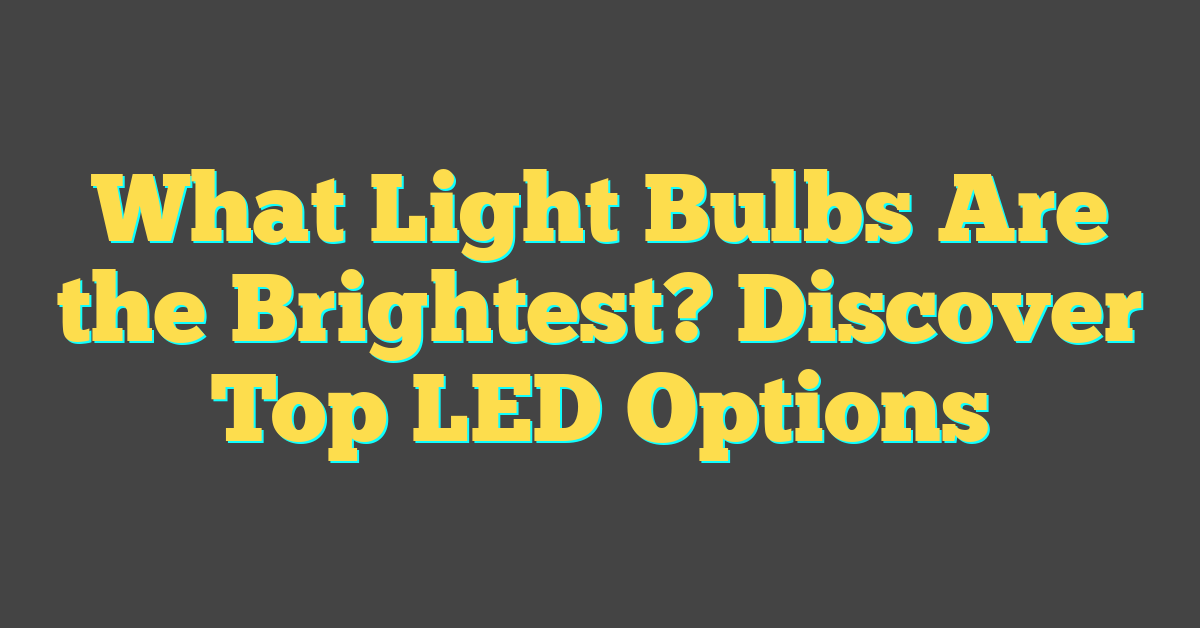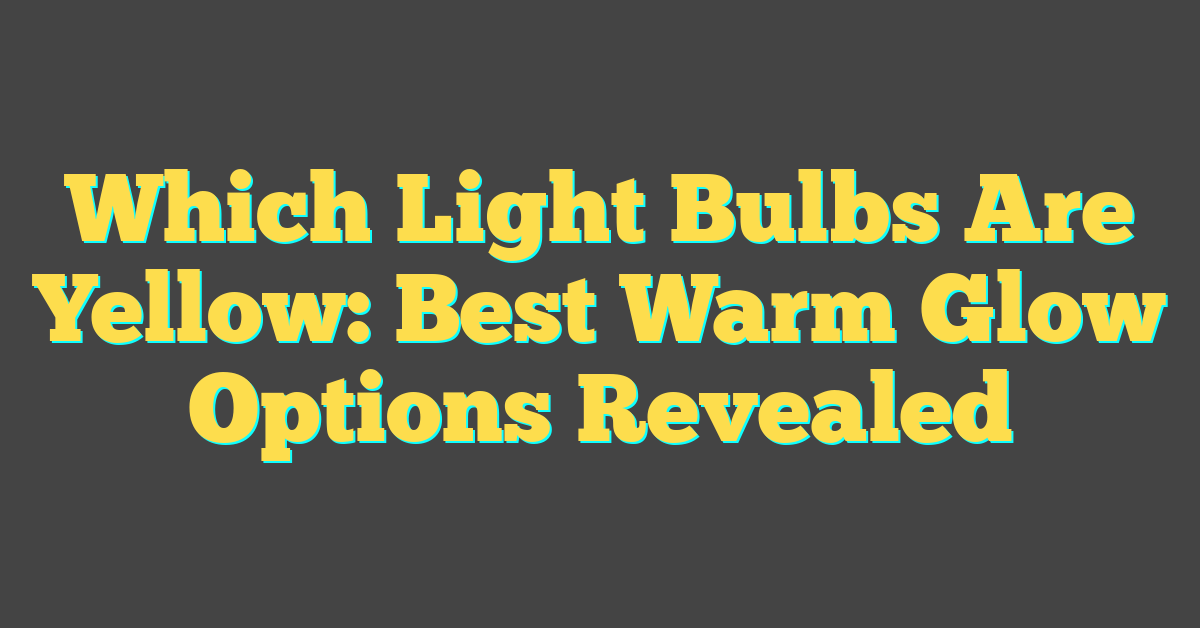Ever walked into a room and felt like you’ve stepped into daylight? That’s the power of a bright light bulb. But with so many options out there, it can be a real head-scratcher to figure out which ones will turn your dim den into a beacon of light.

You might be wondering, “What’s the secret behind the brightest bulbs?” Well, it’s not just about wattage anymore. Advances in technology have brought us a variety of bulbs that pack a punch without running up your electric bill.
So, let’s shed some light on the subject and dive into the world of high-lumen lovelies. You’re about to discover which bulbs are outshining the rest and how you can illuminate your space like never before.
How Brightness is Measured in Light Bulbs
When you’re on the hunt for the brightest light bulbs around, you’ll need to get familiar with a term called lumens. Lumens measure the actual brightness a bulb produces, as opposed to watts, which indicate energy consumption. The higher the lumens, the brighter the bulb – it’s as simple as that!
But here’s a pro-tip: when replacing bulbs, compare lumens to get the light level you need. To give you a ballpark, a standard 60-watt incandescent bulb emits around 800 lumens. However, with modern LED technology, you can achieve the same brightness for a fraction of the wattage.
It’s also worth mentioning that the color temperature, measured in Kelvin (K), plays a significant role in how the brightness is perceived. Light bulbs with a higher color temperature (5,000K or above) emit a cooler, daylight-like light, which tends to appear brighter to the human eye. In contrast, bulbs with a lower color temperature (around 2,700K) give off a warm, yellowish glow and tend to be perceived as less bright.
When doing your home DIY lighting projects, think about the mood you want to create. A brighter bulb with a higher Kelvin rating may be perfect for task lighting or areas where visibility is key, whereas a lower Kelvin rating might be better for relaxing, ambient lighting.
Lastly, let’s touch on beam angle. The beam angle of a bulb indicates how widely the light is spread. Narrow beam angles concentrate the light, making it appear brighter within a specific area, while wider beam angles disperse the light across a larger space, potentially reducing the perceived intensity.
Remember, lumens, Kelvin, and beam angle are all part of the equation that determines how light affects a space. So next time you’re navigating the lighting aisle, keep these in mind to make an informed decision that’ll shine the brightest light exactly where you need it.
Traditional Incandescent Bulbs: Are they the Brightest?

You might reminisce about traditional incandescent bulbs illuminating your childhood home with their warm glow. Known for their classic look and instant brightness, incandescent bulbs have long been a staple in households. But when it comes to sheer luminosity, do they really outshine their modern counterparts?
Incandescent bulbs operate by heating a thin filament until it glows, a method that hasn’t changed much since their invention over a century ago. They’re loved for their warm color temperature, typically around 2700 Kelvin, which enhances cozy and inviting atmospheres.
However, incandescent bulbs are not champions in the efficiency arena. A staggering 90% of the energy they consume is emitted as heat rather than light. This inefficiency means you’re not getting the brightest bang for your buck. In terms of lumens, incandescent options usually don’t crack the highest numbers available in the market.
Let’s talk lumens. If you’re retrofitting an old lamp and seeking the ambiance produced by a 100-watt incandescent, you’d be looking at about 1600 lumens. It’s ample light for general use, but newer technologies offer far more with less wattage. Here’s a quick comparison:
| Bulb Type | Equivalent Incandescent Wattage | Lumens |
|---|---|---|
| Incandescent | 100 watts | 1600 |
| LED | 14-17 watts | 1600 |
| CFL | 23-30 watts | 1600 |
| Halogen | 72 watts | 1600 |
You’ll find that LED and CFL bulbs can match or exceed this lumen output at a fraction of the wattage. When it comes to ultimate brightness, advancements in bulb technology have eclipsed the old incandescent standard.
« What Is Light Bulb Parking? Master the Art of Snagging the Perfect Spot
What Is Light Bulb Burned Out? 8 Pro Tips to Extend Bulb Life »
One final point to consider is the lifespan of an incandescent bulb. On average, you’d need to replace an incandescent bulb far more frequently than an LED or CFL. This means more time on the ladder for you and more bulbs in the landfill. With lighting advancements, you’ll not only enjoy brighter spaces with fewer bulb changes, but you’ll also be participating in a more energy-conscious lifestyle.
Exploring Halogen Bulbs: A Bright Alternative

When you’re knee-deep in a home DIY project, the right lighting can make all the difference. Enter halogen bulbs, a popular choice for those seeking a brighter light output. Halogen bulbs are akin to your incandescent bulbs, but with a twist: they contain a small amount of halogen gas that allows the filament to glow brighter while using less energy.
You may wonder just how much brighter halogen bulbs can be. They typically provide a more intense light compared to their incandescent cousins. This is because the halogen cycle allows the filament to operate at higher temperatures, yielding a whiter and brighter light. It’s not just bright; it’s crisp, which is just what you need for tasks that require attention to detail.
But it’s not only about brightness—it’s also about efficiency. Historically, halogens have been more energy-efficient than incandescents, though they can’t quite match the strides made by LED or CFL technology. Below is a comparison of the wattage typically used by different types of bulbs to achieve a similar lumen output:
| Bulb Type | Wattage Used |
|---|---|
| Incandescent | 60 W |
| Halogen | 40-45 W |
| CFL | 13-15 W |
| LED | 8-10 W |
Halogen bulbs also outshine some rivals with their color rendering index (CRI), usually scoring above 90 on a scale of 100. This means they’re great for scenarios where color accuracy is key, perfect for intricate paint work or when critiquing the color scheme in a room you’re sprucing up.
Sure, they might not have the lifespan of an LED bulb, but halogen lights are often dimmable and instantly reach full brightness—no annoying warm-up time. Plus, for your DIY projects where precision is paramount, the superior light quality might just be worth the trade-off.
Remember though, as with any bulb type, you should always weigh up the pros and cons when it comes to your specific needs. Whether you’re after atmosphere or sheer power in your illumination, halogens could be the way to a brighter and more efficient home.
Shedding Light on CFL Bulbs: Compact and Bright

When you’re on the prowl for bright lighting options, don’t overlook Compact Fluorescent Lamps (CFLs). CFL bulbs pack a punch in the brightness department, often outshining traditional options given their wattage. Diving into their design, you’ll find that CFLs employ a tube that’s twisted or folded to fit into the space of a standard incandescent bulb.
CFLs have a strong suit: energy efficiency. They consume about 70-80% less energy than incandescent bulbs. So, not only do you save on the electric bill, but you’re also contributing to a greener planet. No small feat for such a compact bulb! Here’s a quick comparison:
| Bulb Type | Energy Consumption |
|---|---|
| Incandescent | 100% |
| CFL | 20-30% |
Bear in mind though, CFLs require a brief warm-up period to reach their full brightness potential. This warm-up period might be a tad inconvenient if you need instant light, but for places where the light stays on for longer durations, it’s a non-issue.
One more thing to consider is the versatility of CFLs. They’re available in a range of color temperatures, making them suitable for various settings, from cool, daylight feels in a study to warm, soft glows in a living room.
And as for brightness, measuring light output in lumens puts CFLs in perspective. While a standard incandescent bulb of about 60 watts gives off roughly 800 lumens, a 14-15 watt CFL can easily produce the same brightness.
Lastly, CFL bulbs stand up well when it comes to lifespan. Typically, a CFL can last about 8,000 to 15,000 hours, which trumps the average incandescent bulb’s 1,000 hours.
- Pros of Using CFL Bulbs:
- Considerations:
Whether you’re retrofitting your entire home or just seeking a bright option for a particular room, weighing these factors ensures you’ll make an informed decision suited to your lifestyle and lighting needs.
The Rise of LED Bulbs: Brightness and Efficiency Combined

LED (Light Emitting Diode) bulbs have surged in popularity, becoming a top choice for both residential and commercial lighting. You might be wondering what sets LEDs apart. Well, LEDs outshine their counterparts by combining exceptional brightness with unparalleled energy efficiency. Unlike CFLs and incandescent bulbs, LEDs light up instantly without a warm-up period, providing immediate illumination.
Let’s dive into the numbers. LED bulbs use about 75-80% less energy than traditional incandescent bulbs and can last up to 25 times longer. To put that into perspective, an average LED bulb can last up to 25,000 hours. That’s a ton of brightness over an impressively long lifespan. Here’s how they stack up against traditional options:
| Bulb Type | Energy Savings | Average Lifespan (hours) |
|---|---|---|
| LED | 75-80% | 25,000 |
| CFL | 70-80% | 8,000 |
| Incandescent | None | 1,200 |
LEDs are not only brighter and more energy-efficient, but they’re also available in a range of color temperatures suited for any ambiance you’re looking to create, from warm, cozy lights to the bright, white glow of daylight. They’re remarkably versatile — you can find an LED option for nearly every type of fixture, from recessed cans to desk lamps.
Conclusion
So you’ve seen the light – quite literally – when it comes to the brightest bulbs on the market. LEDs shine above the rest not just in brilliance but in efficiency and longevity. It’s clear that they’re a smart choice for anyone looking to brighten their space while keeping energy costs down. Remember, good lighting can transform a room and with LEDs, you’re set for years to come. Let there be light and let it be LED!
Frequently Asked Questions
What are the main benefits of LED bulbs compared to traditional incandescent bulbs?
LED bulbs use about 75-80% less energy and last up to 25 times longer than traditional incandescent bulbs. They also light up instantly without a warm-up period.
How long can LED bulbs last?
LED bulbs can last up to 25 times longer than incandescent bulbs, with many models boasting a life span of 25,000 hours or more.
Do LED bulbs offer different color temperatures?
Yes, LED bulbs are available in a range of color temperatures, allowing for customization of lighting ambiance from warm yellow to cool blue tones.
Are LED bulbs suitable for use in various fixtures?
LED bulbs are versatile enough to be used in a variety of lighting fixtures, making them ideal for both residential and commercial applications.




